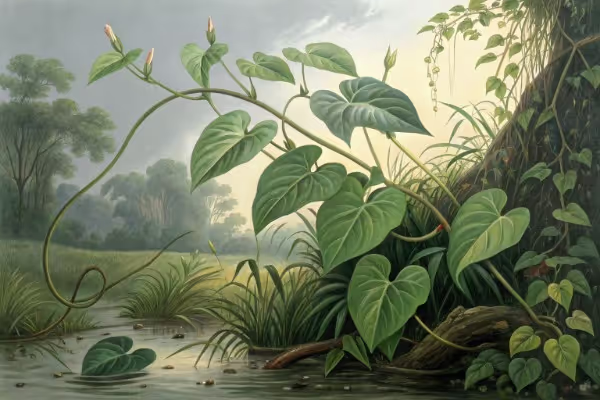Growing Lentils: How to Plant, Grow, and Harvest at Home

Growing Lentils
Growing lentils kicks off best in cooler seasons, thriving in loose, well-drained soil with steady sunlight. Timing seeds early spring gives plants room to sprout and mature before summer heat hits. With lower water demands and a satisfying harvest, growing lentils rewards gardeners with nutritious pods—curious? Grab your gloves, let's get planting.
Cheatsheet: Home Lentil Growing Basics
🌱 Choose Location & Season
- Full sun
- Well-drained, loose soil
- pH 6.0–6.5
- Sow after last frost (50–85°F / 10–29°C)
🛠 Tools and Products You'll Need
- Lentil seeds
- Trowel or hoe
- Row marker or string
- Watering can or drip system
- Harvesting shears
🌾 Planting Steps
- Prepare soil: Loosen to 2 in (5 cm) deep
- Sow seeds: 1 in (2.5 cm) deep, 1 in (2.5 cm) apart, rows 12 in (30 cm) apart
- Water lightly: Keep moist, not soggy
- Thin seedlings: 4–5 in (10–12 cm) apart at 3 in (7 cm) tall
🌞 Growing & Care
- No fertilizer unless soil is poor
- Avoid standing water
- Weed regularly
- Mulch to conserve moisture
- Add trellis if stems flop
🗓️ Harvest
- 80–110 days to harvest
- Pods dry, turn yellow/brown
- Uproot & hang to dry if rain threatens
- Thresh and winnow seeds
🥗 Nutrition & Self-Sufficiency
High in protein, iron, & fiber. Fix nitrogen in soil, boosting future crops.
-
Growing Lentils: How I Plant, Grow, and Harvest at Home
I sow lentils the day soil stops clumping like cold cheese and a trowel slides clean. Cool air steadies them, and they repay with quiet abundance.
Quick facts that actually help
- Botany: Lens culinaris, cool-season annual, Fabaceae.
- Soil pH: 6.0 to 7.5, well-drained loam or sandy loam preferred.
- Optimal temps: 60 to 70 F, 15 to 21 C.
- Planting window: early spring, 2 to 3 weeks before last frost if soil is workable.
- Days to maturity: 80 to 110, cultivar and climate dependent.
- Plant height: 12 to 20 in, 30 to 50 cm, with fine tendrils that tangle if crowded.
- Water needs: steady but light, about 1 in, 25 mm per week once established.
“Dry lentils deliver about 24 to 26 percent protein” — USDA FoodData Central
Site and soil prep for Growing Lentils
Lentils hate soggy feet, so I pick a bed that drains after a hard rain within an hour. Raised rows or gentle mounds help if your soil holds water.
I broadfork first to lift without flipping the soil profile. Then I rake in a light compost dressing, about 0.5 inch, 1.25 cm, to feed soil biology without overdoing nitrogen.
Phosphorus and potassium matter more than nitrogen for this crop. A soil test guides me, and I add rock phosphate or bone meal only if P tests low.
Seed quality and variety choice
I buy certified, disease-free seed to dodge Ascochyta and seed-borne anthracnose. Food-bag lentils sprout but bring hitchhikers I do not want in my beds.
Top home-garden lentil varieties I rate
- Eston small green: early, tidy plants, 85 to 95 days, great for short seasons.
- French green Puy-type: speckled seeds, holds shape in the pot, 90 to 100 days.
- Beluga small black: quick, flavorful, easy to thresh, 80 to 90 days.
- CDC Maxim small red: productive in cool summers, 95 to 105 days.
- Pardina Spanish brown: steady yielder, forgiving in variable springs.
Small-seeded types mature faster and handle erratic springs better. I pick two contrasting types to spread risk and harvest window.
How I sow lentils for an even stand
I plant as soon as soil hits 40 F, 4 to 5 C, and is crumbly. Lentils handle light frost, and early planting avoids heat at bloom.
Depth: 1 inch, 2.5 cm, in firm seedbed. Spacing: 1 to 2 inches, 2.5 to 5 cm, in-row, rows 6 to 12 inches, 15 to 30 cm, apart.
For a dense mini-plot, I broadcast, then rake to cover and tamp with the back of the rake. Consistent depth drives uniform emergence.
Inoculation that actually pays
I dust seed with a peat-based inoculant of Rhizobium leguminosarum bv. viciae before sowing. Nodulation means the roots form pinkish nodules that fix nitrogen from air.
If lentils or peas have not grown there in 3 to 5 years, inoculate or leave yield behind. I moisten seed lightly so the inoculant sticks, then plant the same day.
“Field trials show lentils can fix roughly 40 to 90 kg N per hectare” — ICARDA, cool-season legume research
Fertility without overfeeding
Lentils sulk with excess nitrogen, so I skip high-N fertilizers. I aim for 20 to 30 ppm soil P and balanced K, then let nodules do the heavy lifting.
A micronutrient hiccup shows as pale tops even with nodules present. I foliar-feed with sea mineral at early bloom only if a test flags deficiency.
Water, mulch, and canopy management
I water lightly but steadily until first flower, about 1 inch, 25 mm per week including rain. After pod set, I ease off to reduce foliar disease.
A thin straw mulch keeps soil from crusting and protects low pods from soil splash. I never mulch too deep or mice throw a party.
Lentils rarely need trellis, yet a low string between stakes every 3 feet, 90 cm, keeps rows upright in summer squalls. Clean airflow beats foliar blight.
Companions, rotations, and soil health
I rotate lentils on a 4-year loop with brassicas, roots, and then cereals. This breaks disease cycles and spreads fertility gains.
Interseeding a sparse nurse strip of spring oats lends structure and reduces lodging. I mow the oats above pod level once flowering begins.
Pests and diseases I actually see
Ascochyta blight and anthracnose
These hit hard after long wet spells. I use clean seed, wider rows, and avoid overhead water after noon.
Seed treatments help in farm fields, but I lean on sanitation at garden scale. Pull and trash badly hit plants to limit spore showers.
Gray mold and white mold
Dense canopies stay wet and invite Botrytis and Sclerotinia. I thin to a palm-width between plants and keep beds weeded so air moves.
Aphids and bruchids
Aphids colonize tender tips before bloom. A hard water blast early and a quick pass with insecticidal soap keeps them honest.
Seed bruchids show up at storage if pods cure too slowly. I dry seed fast, then freezer-treat for 4 days at 0 F, minus 18 C, to stop hidden eggs.
Harvest timing that beats shatter
I watch lower pods first, not the tops. When bottoms are brown, mids are tan, and leaves mostly dropped, it is go time.
I cut in the late morning after dew lifts to curb shatter. Plants lie on a tarp to cure for 3 to 5 days, turning daily until the pods crackle.
Threshing and winnowing without fancy gear
I stuff brittle plants into a clean contractor bag and tread carefully in boots. Pods pop, and seed falls without grinding the cotyledons.
I pour the mix between buckets in front of a box fan until seed runs clean. Final dry hits about 13 percent moisture for safe storage.
Storage that keeps flavor
I jar seed in airtight glass with a fresh oxygen absorber in a cool 50 to 60 F, 10 to 16 C, pantry. Flavor holds for a year, often longer.
A simple moisture meter removes guesswork. If in doubt, I dry another day.
Yield expectations and kitchen payoff
In my beds, I pull 0.5 to 1.0 pound per 10 square feet, 250 to 500 g per square meter, depending on spring weather. Field benchmarks run near 1.0 to 1.5 t per ha in many regions.
Small greens hold shape for salads, reds melt into soups, blacks shine with vinaigrette. I cook them like I garden them: steady heat, no drama.
Container Growing Lentils
I use a 10-inch, 25 cm, deep box or pot with free-draining mix. Three plants per 3-gallon, 11 L, container give a fair handful of seed.
Keep water tight during bloom, then reduce. A low string corral helps in wind.
Buying guide: seed, inoculant, and helpful tools
- Seed: certified disease-free packets, 100 to 200 seeds, often 3 to 5 USD, choose early types for short seasons.
- Rhizobia inoculant: pea-vetch-lentil group, peat-based, 8 to 15 USD per small pack that treats far more than a garden row.
- Moisture meter: 25 to 40 USD, saves a harvest from mold in the jar.
- Box fan and two buckets: budget winnowing kit, likely on hand already.
- Fine seed sieves: 20 to 40 USD, speed cleanup if you grow several legumes.
I store inoculant in the fridge and watch the expiry date. Live microbes make the difference between pale tops and seeded pods.
Troubleshooting field notes
- Pale plants with few nodules: inoculate next time and avoid high-N fertilizer.
- Plants flop at bloom: reduce water, add a low string, and thin lightly.
- Green, grassy off-flavor in jars: seed too wet, redry to 13 percent and freeze 4 days.
- Blank pods after heat wave: plant earlier next spring to dodge hot bloom week.
- Brown leaf spots climbing up: widen rows, mulch lightly, and avoid late overhead water.
Lentils vs other cool-season legumes for home beds
- Lentils vs peas: lentils need less trellis and dry down cleaner, peas outpace them in early snacks.
- Lentils vs chickpeas: lentils finish sooner in cool summers, chickpeas shrug off drought better once hot.
- Lentils vs fava beans: lentils fit small beds, favas feed bees and soil but take longer and need staking.
Why Growing Lentils feeds your soil rotation
I see better brassicas after lentils without extra nitrogen. Residual fertility and lighter disease pressure make the next crop sing.
That quiet fix of N sets up grains the following season. I plant garlic after lentils and get plumper bulbs with fewer yellow flags.
Anecdotes from years of rows
The best stand I ever grew followed a fall oats cover mowed short in spring. The bed felt springy underfoot, and nodules were pink as salmon.
The worst came after an overfed compost binge. Plants looked lush then lodged and molded, and I earned that lesson.
Citations and trusted references for deeper reading
USDA FoodData Central: nutrient composition of dry and cooked lentils, 2024.
FAOSTAT: global lentil yield and production data, latest release.
ICARDA: Cool-season legumes, nitrogen fixation ranges in lentil field trials.
North Dakota State University Extension, Lentil Production Guide A-1273: planting temps, disease management, and storage moisture.
Oregon State University Extension, cool-season legumes: soil pH, irrigation timing, and inoculation basics.
Frequently Asked Questions About Growing Lentils
What type of soil do lentils need to thrive?
Lentils flourish in well-draining, loamy soil that offers a pH of 6.0 to 6.5. Before planting, enrich the soil with compost to sustain nutrient-rich conditions.
How much sunlight is necessary for successful lentil growth?
Ensure lentil plants receive full sunlight, ideally around 6 to 8 hours per day, to encourage lush growth and healthy pod production.
When is the ideal time to plant lentils?
Plant lentil seeds directly into the soil in early spring, approximately 2-3 weeks before the last frost date. Ideal planting conditions include soil temperatures around 50 to 68°F (10 to 20°C).
How deep should lentil seeds be planted?
Sow lentil seeds at a depth of approximately 1 to 1½ inches (2.5 to 3.8 cm), spaced around 2 inches (5 cm) apart. Space rows about 18 to 24 inches (45 to 60 cm) apart to allow for healthy air circulation.
What watering schedule supports healthy lentil plants?
Regularly water lentils, supplying around 1 inch (2.5 cm) of water per week, maintaining consistent moisture without saturating the soil. Adjust watering frequency during periods of rainfall or extended dry spells.
Do lentil plants require fertilizer during the growing season?
Generally, lentils draw nitrogen from the atmosphere, reducing the need for additional nitrogen fertilizers. However, supplementing with a balanced, phosphorus-rich fertilizer early in the season boosts root development and flowering.
When are lentils ready for harvest?
Lentils mature approximately 80 to 110 days after planting. Harvest when pods turn brown and rattle slightly upon shaking. Avoid delays to prevent pods from splitting and losing seeds.
Do lentils attract pests or diseases gardeners should watch for?
Be vigilant against pests such as aphids and wireworms, as well as diseases like powdery mildew and root rot. Implement crop rotation and practice good garden hygiene to manage these potential issues effectively.
Growing lentils at home is all about patience, timing, and respect for the soil. These hardy little legumes thrive on well-drained earth and cool weather, rewarding you with protein-rich harvests and improved soil health. Start with quality seed, keep the beds weed-free, and let the pods dry on the plant for peak flavor. Rotate your crops, and don’t be afraid to experiment—add a row of azuki beans or bean sprouts for diversity. Lentils don’t need much fuss, but they’ll repay you with more than just food—they build your soil, feed your body, and remind you to slow down and trust the process. If you’re after a crop that gives back, growing lentils is as honest and satisfying as it gets.
The Prepper's Lentil Growing Strategy for Nutritional Self-Reliance
Rapid-Growth Lentil Varieties
- Eston Lentils: Matures quickly, harvest in 80–90 days, ideal for short growing seasons.
- Crimson Lentils: Small plants yield within 85 days, effective soil nutrient usage.
- Brewer Lentils: Hardy variety, drought-resistant, harvests in approximately 90 days.
Space-Saving Cultivation Technique
Interplant lentils beneath taller crops (like corn or sunflowers) to maximize yield per square foot, conserve soil moisture, deter weeds, and optimize limited growing area.
Storing Lentils for Long-Term Nutrition
- Drying Method: Ensure lentils are air-dried thoroughly to below 10% moisture, preventing mold and spoilage.
- Storage Conditions: Pack dried lentils into airtight, moisture-proof containers (Mylar bags or glass jars with oxygen absorbers), keeping storage temps close to 55°F (13°C) to ensure viability and nutrition for 25–30 years.
- Rotation Plan: Keep detailed labeling and record harvest dates, container rotations every 5 years.
Lentils as Essential Survival Nutrition
Lentils contain 18 grams protein per cup, with iron, fiber, potassium, and folate, supporting energy and health during extended emergencies. Shelf-stable and easy-to-cook lentils complement grains for complete protein intake without refrigeration.
Soil Fertility Maintenance Without Chemicals
Rotate lentils every 2–3 years using legumes (peas or beans), root vegetables, and grains, promoting soil nitrogen replenishment naturally, maintaining long-term soil productivity.
Find out which plants will thrive in your garden!
Answer a few fun questions and get custom plant recommendations perfect for your space. Let’s grow something amazing together!

start your season





